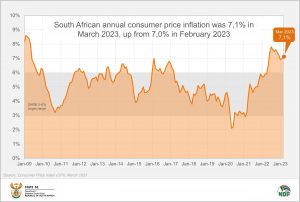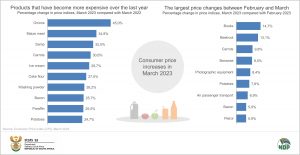Inflation rises for a second consecutive month as food prices bite
Headline consumer inflation edged higher to 7,1% in March from 7,0% in February and 6,9% in January.
The monthly change in the consumer price index (CPI) was 1,0% in March, the most significant monthly rise since July 2022 when it was 1,5%. Food & non-alcoholic beverages and transport were the main drivers behind the annual and monthly increases.
Food inflation continues its upward trend
Inflation for food & non-alcoholic beverages continued to accelerate, with prices increasing by 14,0% in the 12 months to March. This represents the largest annual increase since the 14,7% rise in March 2009 (14 years ago).
In March, milk, eggs & cheese; sugar, sweets & desserts; fruit and vegetables; and the product category ‘other food products’ experienced upward inflationary pressure. The milk, eggs & cheese product group witnessed its annual rate reaching 13,6% from the recent low of 3,7% in April 2022. The reading in March is the highest annual increase since February 2009’s print of 13,9%.
Bread & cereals, meat, oils & fats, and fish bucked the trend, recording slower growth. The annual increase for bread & cereals was 20,3% in March, down from 20,5% in February. Meat inflation edged lower to 10,6% from 11,4% in February. Prices of oils & fats decreased for a seventh successive month, dragging the annual rate to 16,0% from 16,7%.
Transport inflation down on lower fuel prices
The transport index rose by 8,9% in the 12 months to March, down from the 9,9% annual rate recorded in February. The downward shift was led by eight consecutive months of slowing fuel inflation, which reached 8,1% in March from 10,9% in February. This is much lower than the 56,2% peak in July 2022.
However, fuel prices rose by 4,5% between February and March. This was mainly due to the price of inland 95-octane petrol rising by R1,27 per litre.1
The latest data on education fees
Education fees are surveyed once a year in March. Overall, fees increased by 5,7% in 2023, higher than the 4,4% rise recorded in 2022. Fee increases were recorded for primary and pre-primary schools (up 6,3%), secondary schools (up 5,8%) and tertiary institutions (up 5,3%).
Other education-related products and services that recorded price increases include crèches (up 4,6%), university boarding fees (up 6,7%), textbooks (up 11,3%) and school bags (up 10,6%). The 11,3% rise in textbooks is the largest annual increase since October 2009 (12,0%).
Other notable price changes in March
New excise taxes for alcohol and tobacco products came into effect in March, contributing to a monthly increase of 2,2%. However, the annual rate dropped slightly to 6,2% from 6,3% in February.
Data for the first quarter survey of housing rentals is also included in the CPI for March. Annual inflation for actual rentals was unchanged from December at 2,5%, while owner-occupied housing was 2,7% compared with December’s reading of 2,8%.
In March, inflation for household contents and services rose to 6,9% from 6,2% in February. This is the highest annual increase since June 2009 (7,0%). Prices for appliances, tableware and equipment rose by 7,7%.
Domestic worker wages increased by 1,2% in March from December, leading to a 5,2% annual rise – the highest since February 2019 when the same rate was recorded.
Prices for personal care items increased by 11,1% in the 12 months to March. This is the highest annual rate since the 12,0% in October 2009.
The charts below show the products that recorded the largest percentage price increases in March.
1 Department of Mineral Resources and Energy. Petrol price archive (click here).
For more information, download the February 2023 CPI statistical release here. Access the archive here.
Similar articles are available on the Stats SA website and can be accessed here.
For a monthly overview of economic indicators and infographics, catch the latest edition of the Stats Biz newsletter here.



